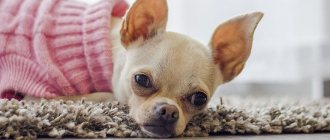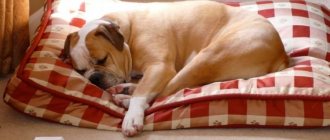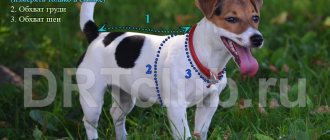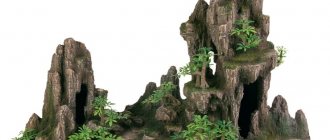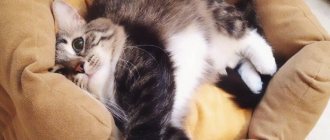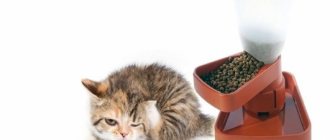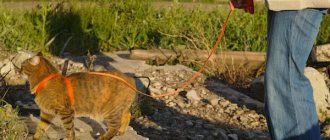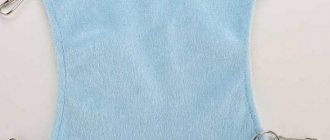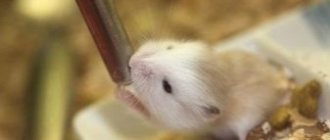How to sew clothes for a dachshund and a toy terrier with your own hands
Before you begin the process of sewing or knitting, you need to take measurements from a small model.
Required measurements
Practical recommendations for taking the size of a dachshund
- Measurements of the dog are made only in a sitting position.
- The resulting measurements may fall between two sizes. Then you should lean towards a larger size.
- When taking measurements, the degree of fit of the future suit is taken into account.
- Back length (DL) is the dog’s body (along the spinal column), measured from the base of the neck, where the collar sits, to the beginning of the tail.
- Chest Circumference (CH) is the chest measured at its widest point, just behind the forelegs. To ensure the freedom of fit of the future suit, add a couple of centimeters to the size of the OG.
- Neck circumference (NC) – the dog’s neck is measured at its widest part.
DIY sewing
Dachshund clothes can be bought at a pet store or ordered online. But if the owner has sewing skills and a desire to make a unique costume for his pet, then sewing a wardrobe at home is a good idea.
How to properly take measurements of a dog?
In order to take measurements from a dachshund you need:
- Prepare a measuring tape and a sheet of paper.
- Place the dog flat on the floor or table.
- Measure the following parameters with a centimeter:
- back length (from neck to tail);
- chest circumference (the widest part of the chest);
- neck girth;
- paw length (from base to pastern).
If the clothes have a hood, then you need to measure the volume of the head and the distance between the ears.
All girth values must be written down, halving them.
Modeling and circuit development
In order to make a pattern for a future suit you need the following:
- Take a sheet of soft paper the size of your back (plus 10 centimeters) and chest circumference (plus five to six centimeters).
- Measure a length equal to the distance from the neck to the front paws.
- Make outlines for the paw line.
- From the fold line, count half the distance between the front paws and make slits.
- Try the pattern on your dachshund and secure with pins.
- Make darts and adjust the length (the fabric on the stomach should be shorter than on the back).
The photo shows the pattern diagram:
Sewing Features
Before sewing clothes for your pet yourself, you need to consider some features:
- Dachshunds are long-bodied dogs, so their clothing should be loose.
- Dachshunds are prone to respiratory diseases. High collars on suits or a separate shirtfront that covers the neck will reduce the risk of getting sick.
- The skin under a dog's tail is very sensitive and easily irritated. Therefore, you need to make the hole for the tail wide enough.
A person trying his hand at sewing for the first time should start replenishing his dachshund’s wardrobe with a blanket. This is the simplest version of a dog costume.
Option for overalls for males
Overalls pattern for a dachshund
- You need to measure the back of the model, as indicated above, to find out the value of DS (see side W-K in the figure).
- Divide the DS value by 8 to find out what the length of one cell of the diagram is in centimeters (we find out the scale of the pattern).
- Draw a sheet of paper into cells, taking into account the information from point 2), that is, you need to know how many centimeters one cell of the diagram is equal to.
- Mark the main points of the diagram with crosses. Connect all the dots.
- Cut out two such parts (M-F-Z-K-D-I-L-G-B-N). Along the outside of the overalls (Z-A-B-K) you need to add 3 cm.
- Cut out the inner sides of the trousers:
- Cut out two parts (F-B-N-M) and two parts (G-D-I-L)
- Sew the halves of the pattern with the inner sides of the panties.
- Then measure the chest circumference (B-D) and waist circumference (A-B).
To find out the width of the insert part between the two halves of the overalls on the dog’s stomach, you need to subtract the difference in these areas between the real parameters of the pet and the flat pattern.
- Assembling the overalls
To assemble the overalls, use the instructions below.
Grind the insert in several steps:
- The zipper is sewn in, starting the sewing process from the neckline. Sew up to the dog’s armpit and secure with a knot.
- Start sewing the area under the belly, sew a stitch on the machine up to the groin, and secure the thread.
- Start sewing the insert to the back leg to its center (for bitches).
- Cut a fly on the insert if we are sewing overalls for male dogs.
- Next, the insert is sewn from the throat to the hole for the tail (D-G-B-F).
- The dart must be placed on the stomach so that the overalls fit the dog’s body better.
- The fly is turned (using bias tape).
- The opening for the tail is also treated with bias tape. Provide darts in advance in this part of the overalls.
- Apply bias tape to the hole for the neck and sew a loop on one side of the neckline, and sew a button on the opposite side. As an option, ties or Velcro are acceptable.
- Shorten the legs taking into account the dog's height, sew elastic along the edge, leaving a small overlap over the elastic for comfort of the pet's movements.
A ready-made version of overalls for a boy's dachshund
You can provide two-layer clothing - the overalls themselves will be made of water-repellent fabric, and the inner layer will be made of soft flannel.
Sewing
A universal clothing pattern for a dachshund is carried out as follows:
- First you need to prepare a sheet of soft paper. Its length should be equal to the length of the back from the collar to the base of the tail (DS).
- 10 centimeters are added to the obtained measurements.
- The width of the paper should match the chest circumference (CG). In this case, 10 centimeters are also added.
- A sheet of paper is folded in half and a rectangle is obtained with sides (DS+10) and (OG+10), divided by 2.
- Next, mark the line of the front paws on the sheet. To do this, you need to add 5 centimeters to the length from the neck to the front paws (DOL).
- From the fold line of the paper you need to retreat a distance equal to the value (DOL+5) divided by 2. Then in this area you should cut out holes for the paws.
- The pattern is tried on the dog and the edges of the paper are connected with pins.
Taking measurements
As a result, you will get 4 darts, and they will be located on the stomach.
When adjusting the length of the product, you need to take into account that in the abdominal area the fabric should be shorter than on the back.
- The pins are then removed and the dog is freed from the pattern.
The resulting layout is suitable for sewing overalls, suits, blankets and dresses for your dachshund with your own hands.
Important! The pattern should fit loosely on the neck and stomach, but at the same time slightly tighten the chest area.
Before you start sewing, you should mark a line where the darts will be located. This will allow you to achieve the greatest comfort in fitting the material.
To make a suit with sleeves for a dachshund with your own hands, you will need to take additional measurements, namely the length of the paws (DL).
To create a blanket with a fastener (Velcro or buttons) you will need:
- Pattern.
- Dense material (70 to 70).
- Bias tape.
- Clasp.
Ready-made overalls
Sewing blankets includes the following procedure:
- The fabric is laid out with the wrong side up.
- The paper pattern is placed on the fabric and outlined with chalk or soap.
- Cuts are made on the fabric along the perimeter of the model, retreating 1 cm (to leave a supply of material).
- Next, fabric in the shape of a rectangle 11 by 17 cm is sewn along the chest line;
- A dart and piping is made on the back of the suit.
- A fastener is sewn on the chest part of the product.
If you need to insulate the blanket, you can use padding polyester or fleece for the lining.
To create a jumpsuit for a boy's dachshund, you need to perform the following steps:
Pattern
- Prepare a pattern.
- Insert the elastic into the hood.
- Attach the hood to the neck.
- Sew the parts of the visor by placing them right sides together.
- Finish the edges of the visor.
- Sew it to the front of the hood.
- Connect the material from the sides and on the stomach.
- Then sew on the sleeves.
- Thread the elastic bands into the cuffs.
Another option
Modeling: changing a finished universal pattern
If your skills in clothing design are minimal, but you want to create an outfit for your pet, you can use a universal pattern with a comfortable fit.
Universal pattern of overalls for dogs
- You need to get a sheet of paper (it’s better to take a soft one) of the following size:
- length - DS+10 cm
- width - OG+10 cm.
- Fold the sheet in half, obtaining a rectangle with sides DS+10 and (OG+10)/2.
- At a distance of DOL+5 from the narrow edge, mark the line of the dog’s forelimbs.
To make holes for the paws, you need to retreat half the distance between the front paws from the fold line on the sheet.
- Place a sheet with a pattern on the tailed model, and pin the edge of the “pattern pipe” onto the dog’s back with pins. Darts are required where the pattern does not fit to the body. This is usually the stomach and neck. These darts laid out on paper are subsequently taken into account when cutting is done. There are usually 3-4 darts placed on the neck, two of them will be on the chest, and the rest will be on the back.
- The dog will also have darts on the belly in the area of the hind legs.
- At the end of the work, the length of the future suit is specified. Blouses are made longer on the back than in the abdominal area so that they do not interfere with the dog while walking.
- After adjusting the pattern, the paper is removed from the dog.
A universal pattern will come in handy when you need to design a jumpsuit, blanket, or sweater for a dachshund or toy terrier. For overalls, you will need to complement the pattern with panties and sleeves.
How to take measurements
An important stage of work, which determines whether the finished product will fit well on the “tail model”. The measurements for males and females are different: the waist line for girls is lower (closer to the tail) than for boys.
Measurements for dogs - main indicators:
- waist and chest circumference;
- back length.
How to measure:
- waist circumference Use a measuring tape to wrap around the widest part of the body under the hind legs;
- chest girth. Measure at the widest point of the dog's body under the front paws;
- back length. The first step is to put on the collar. The second stage is to determine the distance from the strap to the waist line.
Selection of materials
Spokes:
- On the line. Convenient to knit socks, blankets, booties.
- Simple. They knit sweaters, overalls, sweaters.
Hook:
For knitting casual clothes from bulky yarn, choose a thick hook. For an openwork elegant blanket, take a thin hook the thickness of a thin thread.
The yarn labels indicate what thickness the working tool (knitting needles, crochet hook) is suitable for.
Yarn:
- pure wool, thick wool blend - for every day.
- synthetic yarn (acrylic) for extravagant holiday items that are worn rarely and for a short time.
Natural wool allows the skin to breathe, but in synthetic clothes the dog will quickly freeze.
Recommendations for craftswomen
- Ideas for making a blanket, vest or overalls for a pet are searched on the Internet, on specialized sites dedicated to dog breeding, as well as on resources for needlewomen. By using your imagination, you can get an outfit with a twist that no one else has.
- Making your own wardrobe for a dog will allow you to make it extensive, for any weather and without extra costs.
- If you don’t have time, you can use a simple method to insulate your friend. A sleeve is cut off from an unnecessary children's woolen jacket, in which holes are cut for the paws. If you overcast the edges, the item will look finished.
How to knit a jumpsuit for a girl's dog
Ready-made overalls for your pet
For work you will need:
- Knitting needles No. 3, No. 4. Knitting needles on fishing line are preferable.
- Yarn (150 grams) – mohair, wool, wool blend, angora. Leftover wool from past crafts will come in handy.
- Large pin
Below is a master class on making a knitted jumpsuit.
Knitting the neck
Cast on 63 stitches on the needles. Knit 3 cm elastic bands 1 x 1
Knitting the main fabric
After ribbing, knit the fabric with facial loops, adding 6 stitches evenly in each facial row. This is done 5 times.
Knitting panties for the front legs. Pants leg No. 1.
They begin to knit after 12 cm from the elastic neckline.
- To do this, knit 19 loops and remove them with a pin.
- From one more ball, 10 new loops are cast on the knitting needles, the next 19 loops are knitted and 9 more new loops are cast on. These 38 stitches (the beginning of one trouser leg) are knitted in stockinette stitch 6 cm.
- Then knit three rows with a 1×1 rib. Close the loops. Throw the first 19 loops from the pin onto the right knitting needle and cast on 19 new loops from the new ball - this is the base for the 1st pant leg. Then knit 7 loops from the left knitting needle.
Knitting panties for the front legs. Pants leg No. 2.
They also pick up new loops from one ball and knit a second pant leg from these 38 loops.
- Cast on 19 loops for the base of the 2nd leg from the ball with which the middle 17 stitches are knitted, and knit the remaining 19 loops on the left knitting needle.
- Next, knit 9 cm straight, then begin to decrease evenly: in rows 1 - 3 - 4 sts, in rows 4 and 5 - 5 sts.
- There are 71 stitches left on the needles. Knit further straight 24 cm, and in the next front row evenly add 10 stitches.
Knitted clothes for dachshunds are easy to make and practical, as are knitted
pants for the hind legs.
- To do this, knit in short rows in front rows: knit 32 p., 31 p., 30 p., 29 p. in sequence.
- From the new ball, knit the same loops from the other edge of the part. After this, knit all 81 stitches in 4 rows. Next, knit 32 stitches, the next 17 loops. close off and knit the remaining 32 sts.
- One side of the piece: * knit in short rows - from 32 sts, knit 27, 26, 25, 24 in sequence. In the next row of 32 sts, knit the first 16 sts with an elastic band 1x1 - 2.5 cm (the rest the loops remain on the left needle) and bind them off.
- For the trouser leg, cast on 13 sts from the new ball, knit 16 sts with the same thread from the left knitting needle and cast on another 13 sts. With the resulting 42 sts, knit 7 cm, knit the last 3 rows with a 1x1 elastic band and bind off the loops.
Knit the second leg in the same way, starting with the * sign.
Knitting straps
Knit a strip 5 cm wide and 45 cm long, which is then sewn to one of the back halves. The bar will protect the back from bulging.
Jumpsuit fastener
Pieces of Velcro, sewn evenly to the bar, will play the role of a fastener.
Final touches
Sew along the sides of the trouser legs for the front legs, sew the free parts of the trouser legs into the armholes. Sew along the sides of the legs for the hind legs and sew on the edge of the elastic that runs along the back edge of the overalls.
How to knit a hat for a dog
The simplest hat for a dog does not require much time or knitting experience.
Step-by-step instruction:
- Measure the circumference of the dog's head. Divide the resulting number in half. This will be the width of the product.
- Select yarn and pattern for knitting or crocheting.
- We knit the sample and calculate the loops as usual.
- Cast on the required number of loops and knit a rectangle. Its height is equal to the distance from the dog’s eyebrows to the beginning of ear growth. We received the frontal part of the cap.
- Divide the number of loops by 3 and close 1/3 of the loops along the edge on both sides, thereby forming slits for the ears. We knit the middle third with straight fabric until the ears grow. This will be the parietal part.
- For the back of the head, we evenly cast on both sides the number of loops slightly less than the original one. We knit a straight fabric to the height of the frontal part. The back of the head will be a little narrower, but this was done specifically to better fit the dog’s head.
- Now all that remains is to sew the sides of the wide parts.
- We make a fastener or make ties, sew on a pompom, and decorate with taste and imagination.
Your pet will definitely like this hat for his four-legged friend. Because most of all, dogs value the care and attention of their owner. And for this they are ready to do anything.
Crochet women's hat
What is a cap with a straight visor called?
Pet clothing size chart
Beautiful clothes for your pet can be selected and purchased in a specialized store in accordance with the sizes presented in the table.
| Size | Back length | Chest circumference | Breed |
| TK-S | 33-35 | 45-49 | miniature dachshund |
| TK-M | 36-38 | 48-52 | miniature dachshund |
| TS-L | 44-46 | 57-60 | standard tax |
| TS-XL | 48-50 | 65-69 | standard tax |
If necessary, it is not difficult to build a costume for your tailed friend if you have patience and have minimal needlework skills. The pet will receive a wardrobe, the size of which depends only on the owner’s wishes, and will remain healthy and cheerful in any weather.

